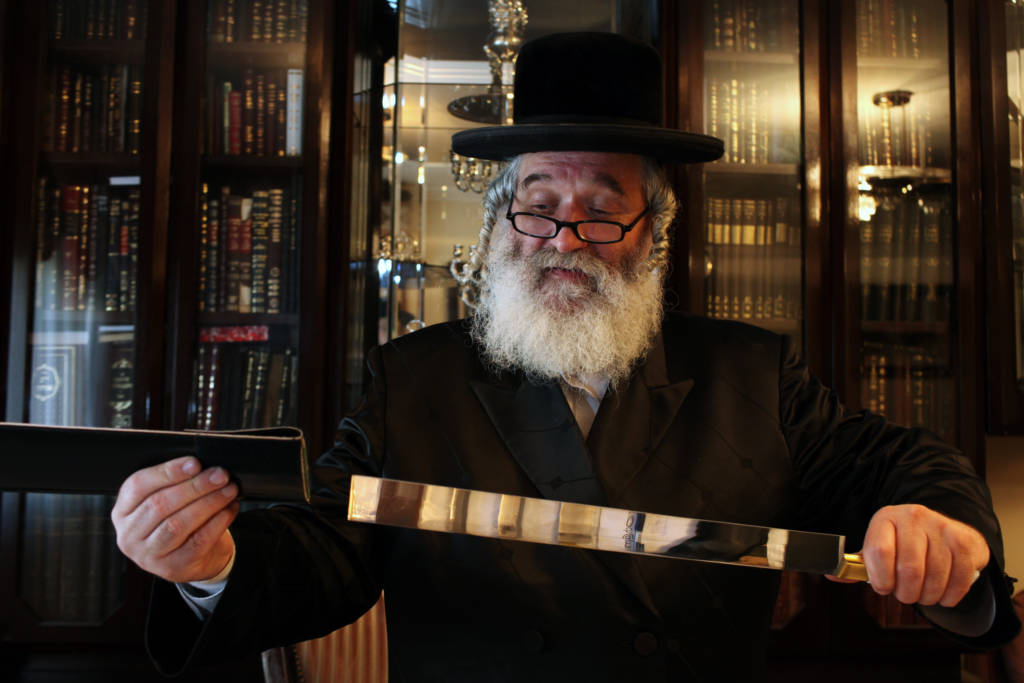In order to eat meat, animals must be of a kosher species and must be slaughtered in accordance with ritual law.
By Rabbi Ari Enkin, Rabbinic Director, United with Israel
This week’s Torah portion is “Reeh” (Deuteronomy 12:21) and in it we read about the laws of kosher. In this article we will focus on one particular aspect of kosher eating and that is “shechita” – kosher slaughter of animals.
In order to eat meat, animals must be slaughtered “as I have instructed you.” However, if one was to analyze the Torah backwards and forwards one will not find any instructions anywhere on how kosher slaughter is to be performed.
As such, this is one of several passages that allude to an “oral Torah” and oral tradition on how to practice Judaism handed down from Moses to Joshua and onward from teacher to student. It is these traditions that make up the Talmud. Not everything is in the Torah.
But back to kosher slaughter. Of course, it does not help to properly slaughter an animal that is of a forbidden species. The only animals that may be eaten are animals that chew their cud (“ruminants”) and have fully cloven hooves.
Hence, we need two features to permit meat: 1. a kosher species 2. that was slaughter as required. One without the other makes the meat completely forbidden. Fish do not require kosher slaughter and any fish with fins and scales may be consumed. Birds that “have a tradition of being kosher” may be eater after kosher slaughter. Such birds most famously include chickens, most ducks, and most breeds of Turkey, among several others.
The rabbi who slaughters animals is known as a “shochet”. The training to become a shochet is rigorous and demanding. There are hundreds if not thousands of laws that a shochet must master before being permitted perform shechita. Every community in history had shochets who would serve the community as it was very uncommon for the average person, even a rabbi, to do shechita on his own. It is indeed a specialization. As such, the shochet was a highly respected member of the community second only to the chief rabbi.
The special knife used for shechita is known as a “sakin” or “chalaf” and must be longer than the neck of the animal it is being used to slaughter. As such, shechita knives generally come in two sizes, “bird size” and “animal size”. The shechita procedure essentially requires the windpipe and food pipe (trachea and esophagus) to be severed. Shechita is intended to cause a rapid drop in blood pressure in the brain and loss of consciousness. This in turn renders the animal insensitive to pain with death occurring in seconds. If the shochet did not sever the entirety of both the trachea and esophagus, then an animal may still be considered kosher as long the majority the trachea and esophagus are found to have been severed.
There are five principles to kosher slaughter, a topic that the shochet-in-training spends months studying and mastering, which we will summarize here. If any of these five principles is violated the animal is not kosher.
Shehiyah (“delay” or “pausing”) – Any pause in the course of slaughter makes the animal non-kosher. The knife must be moved across the neck in an uninterrupted motion until the trachea and esophagus are sufficiently severed. This is usually accomplished in one slice, though additional “back and forth” is acceptable when needed as long as the motion is continuous.
Derasah (“pressing” or “hacking”) – The knife must be drawn across the neck by a back-and-forth movement. The animal may not be killed by an act of chopping, hacking, or slicing without moving the knife back and forth.
Haladah (“covering”) – The back of the knife must be visible at all times. The knife may not be covered by fur and the like.
Hagramah (“slaughtering in the wrong location”) – The slaughter must be in the done through the neck. Cutting or killing the animal via any other wound is forbidden. Anywhere in the neck is legitimate, with the neck defined as from the large ring in the windpipe to the top of the upper lobe of the lung when it is inflated. As such, you can slaughter a giraffe anywhere on its long neck…if you can catch one.
Ikur (“tearing”) – If either the esophagus or the trachea is torn during the slaughter the animal is rendered non-kosher. Ikur can occur, for example, if the esophagus or trachea is torn by a knife that has nicks or other imperfections in it. In order to avoid this problem, a shechita knife is examined frequently, sometime after every single slaughter.
Do You Love Israel? Make a Donation - Show Your Support!
Donate to vital charities that help protect Israeli citizens and inspire millions around the world to support Israel too!
Now more than ever, Israel needs your help to fight and win the war -- including on the battlefield of public opinion.
Antisemitism, anti-Israel bias and boycotts are out of control. Israel's enemies are inciting terror and violence against innocent Israelis and Jews around the world. Help us fight back!
